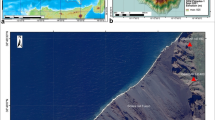Abstract.
Limit equilibrium analyses were applied to the 1980 Mount St. Helens and 1956 Bezymianny failures in order to examine the influence on stability of structural deformation produced by cryptodome emplacement. Weakening structures associated with the cryptodome include outward-dipping normal faults bounding a summit graben and a flat shear zone at the base of the bulged flank generated by lateral push of the magma. Together with the head of the magmatic body itself, these structures serve directly to localize failure along a critical surface with low stability deep within the interior of the edifice. This critical surface, with the safety coefficient reduced by 25–30%, is then very sensitive to stability condition variation, in particular to the pore-pressure ratio (ru) and seismicity coefficient (n). For ru=0.3, or n=0.2, the deep surface suffers catastrophic failure, removing a large volume of the edifice flank. In the case of Mount St. Helens, failure occurred within a material with angle of friction ~40°, cohesion in the range 105–106 Pa, and probably significant water pore pressure. On 18 May 1980, detachment of slide block I occurred along a newly formed rupture surface passing through the crest of the bulge. Although sliding of block I may have been helped by the basal shear zone, significant pore pressure and a triggering earthquake were required (ru=0.3 and n=0.2). Detachment of the second block was guided by the summit normal fault, the front of the cryptodome, and the basal shear zone. This occurred along a deep critical surface, which was on the verge of failure even before the 18 May 1980 earthquake. The stability of equivalent surfaces at Bezymianny Volcano appears significantly higher. Thus, although magma had already reached the surface, weaker materials, or higher pore pressure and/or seismic conditions were probably required to reach the rupture threshold. From our analysis, we find that deep-seated sector collapses formed by removing the edifice summit cannot generally result from a single slide. Cryptodome-induced deformation does, however, provide a deep potential slip surface. As previously thought, it may assist deep-seated sector collapse because it favors multiple retrogressive slides. This leads to explosive depressurization of the magmatic and hydrothermal systems, which undermines the edifice summit and produces secondary collapses and explosive blasts.
Similar content being viewed by others
Author information
Authors and Affiliations
Additional information
Electronic Publication
Rights and permissions
About this article
Cite this article
Donnadieu, F., Merle, O. & Besson, JC. Volcanic edifice stability during cryptodome intrusion. Bull Volcanol 63, 61–72 (2001). https://doi.org/10.1007/s004450000122
Received:
Accepted:
Issue Date:
DOI: https://doi.org/10.1007/s004450000122




